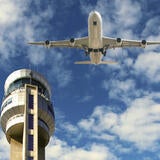January 2020 marked an important milestone for safety in the United States skies. From this momentous day, the Federal Aviation Administration (FAA) has mandated that all aircraft in controlled airspace across the National Airspace System (NAS) must transmit a continuous radio broadcast with identifying information to the ADS-B air traffic surveillance system.
This means that all aircraft in controlled airspace will now automatically broadcast their unique call sign, their precise GPS location, and their velocity to the ground receiving radio network and directly to the cockpit radios of nearby aircraft. Not only does this give pilots greater awareness of traffic around them to avoid potential collisions, it also gives air traffic controller more precise information to visualize aircraft en route and ensure safe separation distances in the sky.
ADS-B is surveillance system that relies on a combination of hardware technology and a comprehensive data sharing network. The system is considered dependent on onboard ADS-B-Out radio hardware to automatically transmit signals and ground station hardware or onboard ADS-B-In radios to receive the messages.
With this new mandate, more than 141,000 of aircraft began broadcasting critical identifying information that feeds into the ADS-B system, letting others know where the aircraft is, which direction it is headed, and at what speed.
Partnering to Create the ADS-B System
Enabling ADS-B system, L3Harris partnered with the FAA in 2007 to develop the ground receiving and distribution network architecture. Within one year following the comprehensive ADS-B network infrastructure buildout, L3Harris began delivering initial operating capability with essential services transmissions. The transmission services include Traffic Information Services Broadcast, or TIS-B, that provides traffic surveillance information from nearby air traffic control radar systems and Flight Information Services, or FIS-B, that provides weather and flight data to the cockpit. Both of these important broadcasts are integrated into the ADS-B network broadcasting system.
Beginning in 2010, before full network buildout was achieved in 2014, the new ADS-B information quickly became integral part of primary surveillance for separation of equipped aircraft in the NAS. Realizing the benefits of ADS-B, early adopters--both air carriers and airlines--have been voluntarily broadcasting signals since the early days of ADS-B and the number of equipped aircraft has steadily increased since. The FAA declared the ADS-B fully operational in December 2019.
The trusted partnership between FAA and L3Harris in developing this capability resulted in successful program milestone achievements and enabled open dialog for collaboration and technology enhancements.
Now, with the FAA’s ADS-B equipage mandate in full effect, air traffic controllers get a more accurate picture of traffic throughout the NAS every second, compared to the 5-12 seconds that radar delivers information. They use the information to monitor aircraft separation to ensure airspace safety.
ADS-B technology not only enables more precise aircraft tracking and eliminates blind spots for traffic controllers, it also provides pilots’ additional situational awareness with radar-based traffic and weather information transmission services. The FAA has seen demonstrated improvements in collision avoidance for aircraft equipped with ADS-B technology even during night and inclimate weather conditions.
Bringing Life to ADS-B – the Ground System Network
The ground system network that enables ADS-B and flight information services delivery to pilots is owned and operated by L3Harris. It is a comprehensive, engineered network that captures the ADS-B information from aircraft overhead and delivers it to the FAA. From our base location in Herndon, VA, L3Harris continuously monitors the network and all its unique components to ensure all data is collected and provided without any disruptions.
The interesting part of ADS-B that is often overlooked is the system engineering work in the background to develop the system architecture, perform software coding, and conduct continual testing to validate information and ensure that the information is flowing reliably. Complex networks, like this, are ever evolving and growing and as new technologies become available, our team works diligently to adapt best practices and advancements with a primary focus on timeliness, availability and security of data flows.
Delivering Innovations to ADS-B
Over the life of the program, the FAA and L3Harris have added innovative technological capabilities to increase the value of the data delivery service. This includes enhanced aircraft position validation, wide-area mulitlateration expansion, enhanced and new Flight Information Services-Broadcast (FIS-B) products to provide weather and airspace information directly to pilots, and information security enhancements to meet current Federal Information Systems security requirements.
Extended air traffic surveillance coverage beyond the coastline has also become possible with ADS-B technology. Advancements such as Aireon’s Space-based ADS-B Global Air Traffic Surveillance system, enabled by L3Harris, or the terrestrial incorporation of ADS-B radios on offshore oil rigs in the Gulf of Mexico and other locations, have expanded the coverage in areas harder to reach. L3Harris and the FAA have collaborated together since 2008 to provide innovative solutions to meet these air traffic surveillance challenges.
As a cornerstone project for the FAA’s Next Generation (NextGen) air transportation system, ADS-B is the first step to modernizing the U.S. air traffic management system and the NAS. Upcoming technologies for the NAS rely on the vital ADS-B information service provided by L3Harris.
With the ADS-B equipage mandate in full effect across the controlled airspace of the NAS, L3Harris looks forward to delivering more innovations to enhance air traffic control situational awareness for both pilots and air traffic controllers. L3Harris continues to reliably deliver the trusted ADS-B data that powers this preferred aircraft surveillance capability that not only enables safer operations in the sky today but will also lead to exciting innovations for the NAS.
As the prime contractor delivering the ADS-B to the FAA, L3Harris continues to evolve the capability with technology innovations that will enable FAA’s future surveillance needs.


